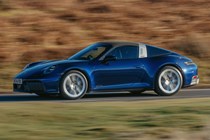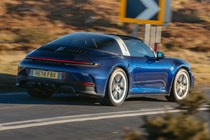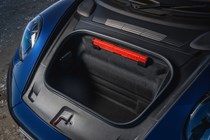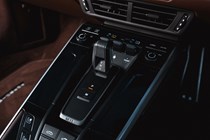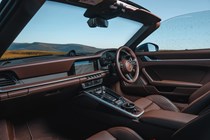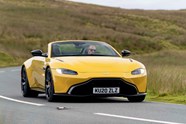
Porsche 911 Targa review
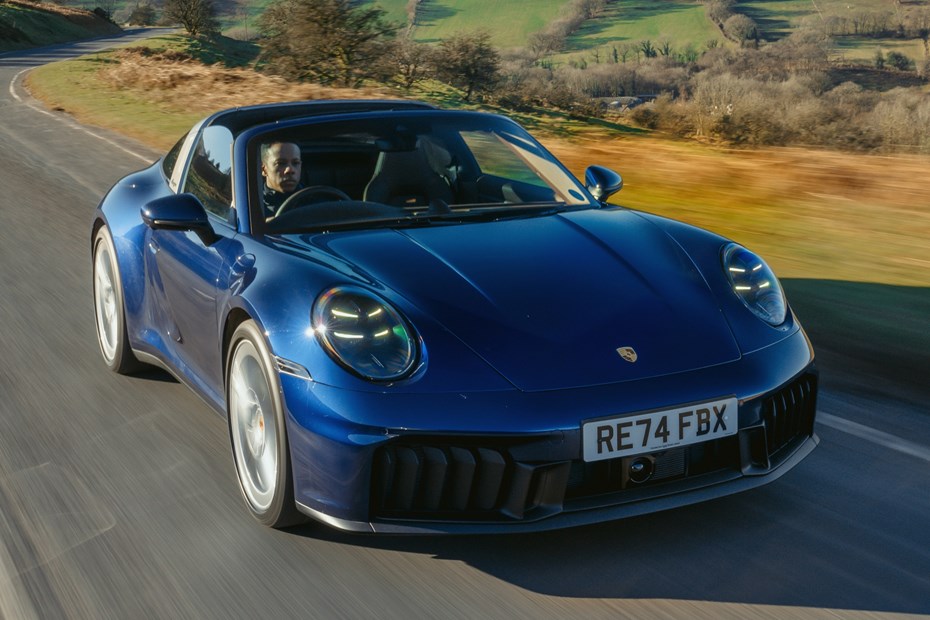
At a glance
| Price new | £142,335 - £159,135 |
|---|---|
| Used prices | £103,562 - £132,090 |
| Road tax cost | £195 - £620 |
| Insurance group | 50 |
Get an insurance quote with

|
|
| Fuel economy | 25.8 - 26.5 mpg |
| Miles per pound | 3.8 - 3.9 |
| Number of doors | 2 |
| View full specs for a specific version | |
Available fuel types
Petrol
Hybrid
Pros & cons
- Thrilling hybrid engine
- Handles almost as well as the Coupe
- Same price as the 911 GTS Cabriolet
- Noisier than 911 Cabrio with the roof down
- Roof only works when you're stationary
- GTS-only
Porsche 911 Targa rivals
Overview
Should you buy one?
Yes. If you’re taken by the 911 Targa’s distinctive look, you’ll be buying a great sports car. However, it is arguably the most pointless of the 911s. A 911 Cabriolet may be more blustery with the roof down, but it’s quieter and has infinite headroom for those in the back as well as the front.
As good as the Targa is to drive, it isn’t quite as sharp or agile as a Coupe, and the single engine makes it an expensive choice. Thankfully, the hybrid-enhanced engine in the GTS is revvier and more responsive than lesser 911 engines.
Overall, I’d still have the 911 Targa over an Aston Martin Vantage Roadster or Mercedes-AMG SL as it’s better to drive and more usable. That said, I’d have a 911 Cabriolet over all of them.
What’s new?
Since its introduction in 1965, the Porsche 911 Targa has offered alternative open-topped thrills to sun-worshipping 911 owners who don’t fancy a Cabriolet. Rather than a full soft-top, Targas get an electrically retracting roof panel between the windscreen and roll bar (painted silver on this example).
Like the rest of the 911 range, a 2024 update has introduced suspension tweaks, the new hybrid powertrain, and a 12.6-inch curved digital driver’s display inside. No facelift would be complete without some new bumpers, colours and wheels, all of which are present and correct here.
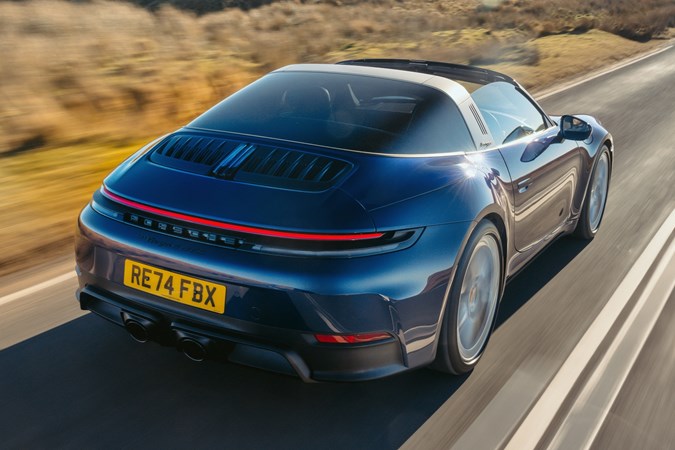
Although previously offered with a range of engines, the updated ‘992.2’ generation 911 Targa is GTS only. That means a 3.6-litre single-turbo flat-six engine with an eight-speed automatic gearbox housing an electric motor. That’s right, it’s a hybrid. Rivals include the BMW M4, Mercedes-AMG SL, Chevrolet Corvette and Aston Martin Vantage Roadster.
Over the next two pages I’ll let you know exactly how good the 992.2 Targa is after spending a couple of hours behind the wheel in the UK. If you want to know how we test cars, there’s a separate page that’ll explain all of that.
What’s it like inside?
Like the coupe, but with a very large sunroof. The new 12.6-inch digital driver’s display has crisp and attractive graphics and a selection of styles including sat nav front and centre, something for the track, or traditional dials. It makes the Targa feel more up-to-date and is thankfully controlled by physical buttons and dials on the steering wheel.
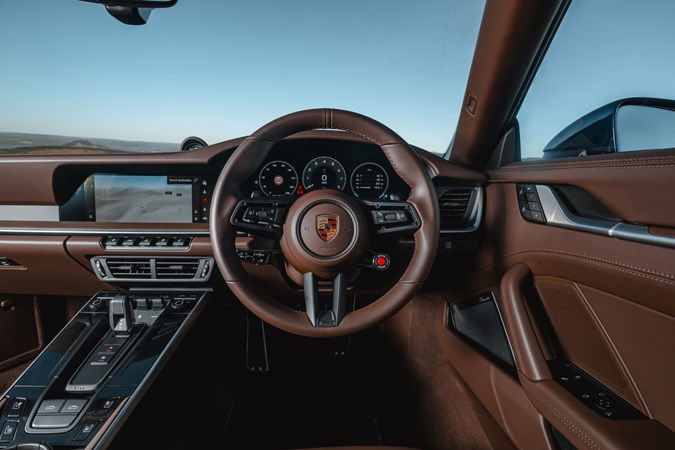
You get a near-perfect driving position (at least with the optional fully electric front seats), plenty of space up front and a few physical controls for key functions. This includes the heating, while all models now get a rotary drive mode selector on the steering wheel. Some may wish for a bit more storage given the usable nature of the 911, but I’m really nitpicking here.
It’s also worth mentioning that 911s no longer come as standard with rear seats, presumably to save a few pounds in both weight and money. Surprisingly, Porsche doesn’t charge to install them if you want the additional practicality. As ever, they’re best suited to children, shorter adults or additional baggage.
Packaging the roof also means the seat backs are more upright, making the Targa’s even less comfortable than the coupe’s. Cabriolet rear passengers get the same seating issue, but enjoy the sun and all the headroom they could want with the roof down.
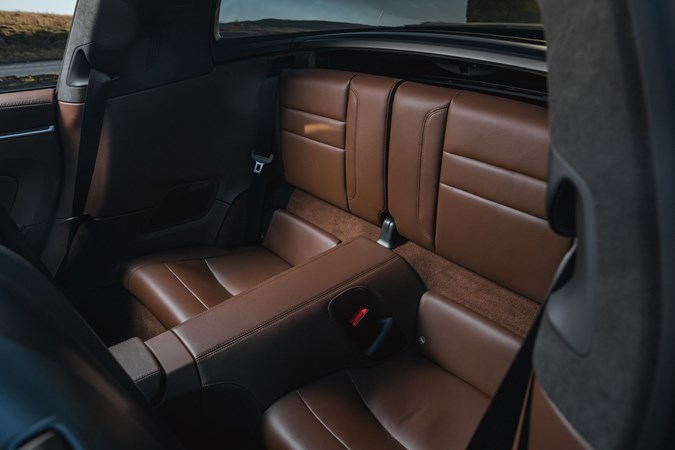
What’s it like to drive?
The Targa is essentially a 911 Cabriolet with a rollover bar. While the missing section of roof means it’s not as structurally rigid as a 911 Coupe, the silver (or black) rollbar adds some strength back into the body. It adds 20kg to the Cabrio’s weight but doesn’t hurt performance according to the official figures. You’ll still notice the odd rear-view mirror wobble, if not as frequently or as much of the already impressive Cabriolet.
You’ll certainly feel less wind in your hair with the roof down in the Targa compared to the Cabriolet. Unfortunately, the Targa’s wind noise is far, far louder at motorway speeds, and you can’t operate its roof when you’re moving at all. The Cabriolet’s works at up to 31mph, and gives a proper open feel as opposed to that of a very large sunroof. It’s the better open-topped 911.
It isn’t just the gearbox that gets an electric motor, there’s one on the turbo, too. This improves throttle response by getting it up to speed faster which, combined with the electric motor in the gearbox, brings throttle response more akin to a GT3 with its non-turbo engine.
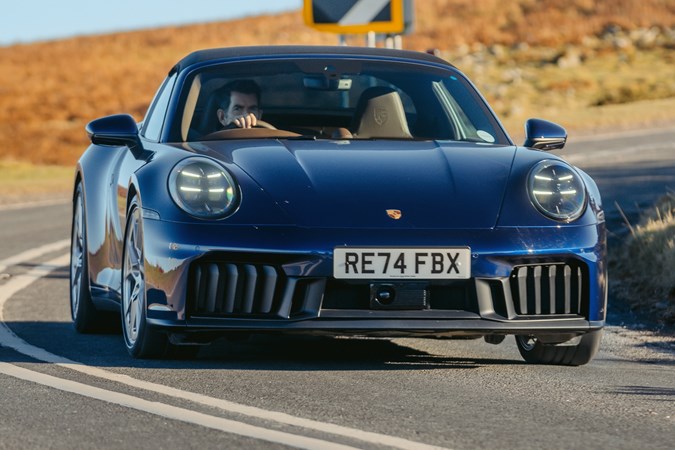
The engine alone is good for 485hp, with the hybrid system boosting it to 541hp. Efficiency wasn’t the key goal here, so it can’t run on electric power alone, but it’s still only 9g/km less efficient than a base Carrera Cabriolet according to the WLTP. It is much, much faster than a Carrera, with fantastic traction in most conditions making the 3.1 second 0-62mph time seem conservative.
Cold, wet roads and ESC Sport mode can have all four tyres spinning in second gear if you boot it coming out of a 40mph speed limit, but it never feels wayward, especially with the ESC on. I found the four-wheel drive only Targa a bit keener to push wide at the front than rear-wheel drive coupes, yet it’ll still wag its tail coming out of corners if you want it to.
Steering and brake feel are both amongst the best in class, and hybridisation hasn’t really made the PDK automatic gearbox any blunter in auto or manual mode. It still shifts plenty smooth enough for everyday pottering about, and the suspension is impeccably damped. Yes, you feel bumps, but they’ve had a layer of cushion applied so none really thwack into the cabin. Sport dampers add even more control and are great when you’re pushing on.
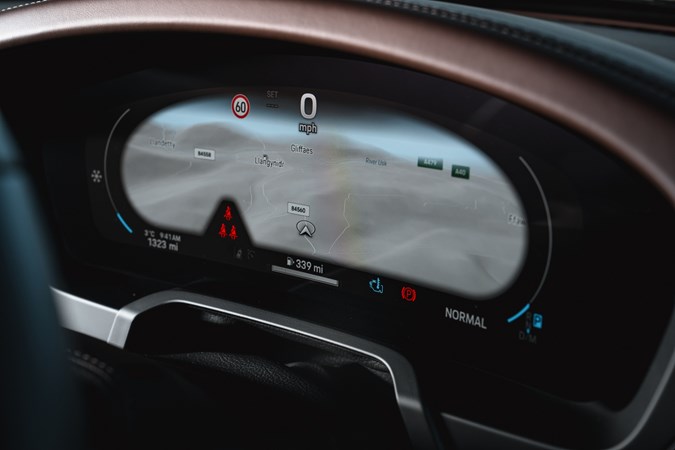
What models and trims are available?
You can only have the 911 Targa in one flavour, and that’s GTS with four-wheel drive. It costs exactly the same as its Cabriolet sibling at around £150,000 and has more standard equipment than the previous car.
Adaptive LED headlights, lane keep assist, traffic sign recognition, brake assist, parking sensors and a rear-view camera take some of the strain off you, while the heated front seats and steering wheel are most welcome during a UK winter. Even so, adaptive cruise control and fully electric seats are optional.
GTS means vertical vents for the new front bumper, and there are of course new colour and wheel choices. This includes a couple with a Taycan-inspired aero look, with more traditional styles also available.



